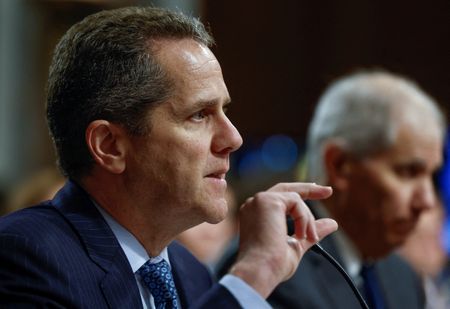By Pete Schroeder
WASHINGTON (Reuters) – The Federal Reserve’s top regulatory official laid out a sweeping plan to increase capital requirements for the nation’s largest banks in the wake of recent bank failures, a move that was immediately met with criticism from the industry.
In a widely-anticipated speech, Fed Vice Chair for Supervision Michael Barr said he planned to pursue multiple regulatory initiatives that would direct larger banks with more than $100 billion in assets to hold more in reserve, saying the recent bank failures underlined the need for regulators to bolster resilience in the system.
“Events over the past few months have only reinforced the need for humility and skepticism, and for an approach that makes banks resilient to both familiar and unanticipated risks,” Barr said in a speech at the Bipartisan Policy Center in Washington.
Barr had been expected to prescribe tighter rules on the sector since being tapped by President Joe Biden to serve as the Fed’s bank watchdog. But Monday’s remarks marked the most detailed view yet of his agenda, and confirmed industry fears he would pursue a broad set of tighter requirements and also ignore their pleas for relief in some areas.
The banking industry called the effort misguided and could hinder lending.
“The changes he outlined today fail to adequately consider the negative repercussions from forcing banks of all sizes to hold more capital than is needed to maintain safety and soundness. Higher capital requirements come at a cost to the economy, and regulators have other existing regulatory tools to manage risks,” said Rob Nichols, president and CEO of the American Bankers Association.
The nation’s largest bank lobby said it would oppose any proposals it deemed unnecessary and economically harmful.
Barr said he did not plan to overhaul the U.S. bank capital framework, but instead build on it in several ways, including by fully implementing the globally agreed Basel bank capital agreement and expanding annual “stress tests” of banks’ health. He did not offer a specific timeline for any changes, but the effort is expected to kick off in the coming weeks.
‘HOLISTIC REVIEW’
Barr’s speech served as a comprehensive update on a “holistic” review of bank capital rules that he launched shortly after joining the U.S. central bank in 2022. He had already indicated at the time that he was considering where rules might be strengthened, but now argues the banking crisis in March and April, which saw the failure of Silicon Valley Bank (SVB) and two other lenders, underlined the need to do more.
“The holistic review began well before then, of course, and the steps proposed here address shortcomings in capital standards that did not begin in March of 2023,” he said. “But in an obvious way, the failures of SVB and other banks this spring were a warning that banks need to be more resilient.”
Specifically, Barr said the crisis proved the systemic role smaller banks can play, which means they also should face stricter oversight. He said he will seek to apply stricter capital rules to banks with more than $100 billion in assets, expanding the pool of firms that must comply.
The banks which would qualify, according to Fed data, include Citizens Financial Group, Fifth Third, Huntington and Regions. The banks did not immediately respond to requests for comment. The stock prices of the first three firms were down at least 0.3% in midday trading Monday, while Regions was up 0.3%.
Dashing industry hopes for any rules relief, Barr also said he did not plan to weaken an existing surcharge on large global banks or leverage rules which the industry argued hampered Treasury market functions. Barr said evidence of that is “inconclusive,” and any impact should be reduced when a fuller set of rules in is place.
However, Barr did emphasize that any new requirements would go through a formal rule-writing and public comment process, and include lengthy transition periods to allow banks to raise necessary capital.
He said that most banks already have enough capital to meet the new standards he has envisioned, but firms that must raise capital would be able to do so in less than two years of retained earnings, while maintaining their investor dividends.
The Fed has itself come under criticism for its oversight of banks involved in this year’s banking crisis. The Republican-led U.S. House of Representatives Oversight Committee on Monday asked Fed Chair Jerome Powell to hand over confidential documents related to the U.S. central bank’s supervision of failed Silicon Valley Bank.
Barr also said on Monday the Fed is close to reaching the appropriate level of interest rates to bring inflation back to its 2% target but “we still have a bit of work to do.”
(Reporting by Pete Schroeder; Editing by Mark Porter, Emelia Sithole-Matarise, Paul Simao and Nick Zieminski)





